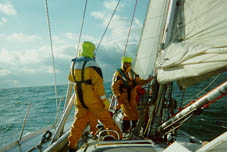|
Most of any sailing day seemed to be spent hauling sails out of the forepeak and into position along the deck, grinding
winches, hoisting and taking down sails, putting in and shaking out reefs, invariably just for the sake of training. Cooking below when angled at 45 degrees presented other challenges, like avoiding nausea. Highlights
came when helming, or taking coffee or Ribena breaks, or when entertained by a crew member who had to stand inside the reefed sail to tidy wayward reefing pennants. The very low, 'lowlights' were times when
each of us felt wet outside and in, freezing and shivery cold, and during a period of inactivity, it did not take too long to get cold. One piece of advice offered was to find an empty winch and to grind, grind,
grind until warm again!Returning into port that evening, I felt quite wet and cold from the sea water which had poured over me from time to time and had consequently seeped into every
part of my foul weather gear. I had visions of a hot shower ashore in mind, but the Skipper had other ideas! With a keen wind whistling past my ears 90 minutes later, I returned from halfway up the oscilllating
mast with sore fingers after a checking-cum-sewing job. This was literally a new high for me in Saturday night entertainment! The next day was similar and involved each Crew Volunteer
took turns to be the Watch Leader. This involved organising other Crew Volunteers to carry out the tasks we had learned and very much needed to practise. Invariably, this meant going up to the bow while it was
leaping high and low, and performing various balancing acts while taking down or putting up a new sail, and getting soaked every time the bow descended into the next trough. All this happened much to the amusement of
the other half of the crew watching from the relative comfort of the cockpit. Any fanciful ideas about getting warm and dry and sitting quietly with a good book for a few minutes
faded fast as the Skipper warned us, "Don't kid yourself that during the race you're going to be able to change into something clean and
dry after many days at sea. You have to get used to sleeping in wet gear. It will dry on you if you sleep in it. Try it tonight."
Later on and reluctantly, I snuggled into my sleeping bag - wet, uncomfortable and unsure of how I might awake. Three and a half hours of luxurious sleep later, I woke to find that the yacht was still crashing
about, but that the wet gear had dried – well, to a degree. The new watch, starting at two o'clock in the morning, had its moments, what with passing phosphoresence in the bow waves, the company of dolphins and a
nuclear submarine surfacing not far away. It all added to the meaning of being there in the shiveringly cold early hours, that dark, inhospitable morning, those very times that you ask youself "What am I doing here?" and the niggling doubts creep in.After the
final briefing on the last day, a fellow Crew Volunteer gave me a lift as far as Honiton after the sail. Derek is an experienced sailor with his own yacht on the south coast. En route, I asked him if he had
doubted himself at all, as to whether he was up to our mighty challenge. He looked at me in complete surprise that I should ask such a question, but spontaneously and reassuringly, he answered "All the time!" Thankfully, it hadn't been just me thinking "Can I really do this? Can I really sail around the
world when life at sea seems to be so very wet, cold and uncomfortable? Can I do this when three of the race legs involve being at sea for more than four weeks at a time?"
A few days later, I joined a "Heavy Weather Sail" on 'Challenge Business 36', the 72 feet prototype yacht for our race in 2000-2001, and was surprised when
one of the most able chaps (in my mind), left the yacht after the first day. He had clearly had enough and had bravely voted with his feet that that was the end of his participation. Why do it?
Such was the question asked of Paul Cayard, the winning skipper of EF language in the last Whitbread race. To paraphrase his answer, he said something to the effect of "You're right. I could be sitting at home in front
of the open fire and reading a newspaper, in warmth, safety and comfort. But there will be time for that afterwards." My own thoughts echo the sentiments. The difference is that, as a professional
sailor, he knows that he can complete the course, he has the strength, the energy, the sailing skills and the knowledge. He is confident in facing the wrath of the Southern Ocean. We Crew Volunteers very
much want to try ourselves out too, but are we made of the right stuff? We shall see. In the meantime, there is cause for celebration, as "Hey, I've done 500 nautical miles."
Back to the top
Copyright © Jan Cambrensis 1999-2004. All rights reserved. |


